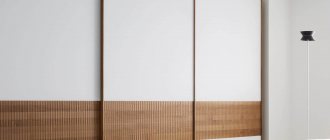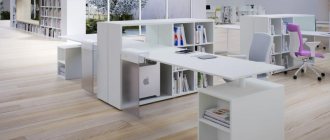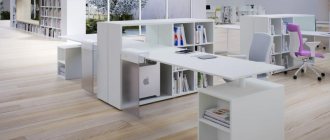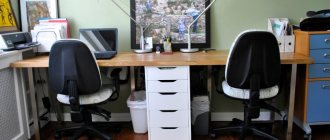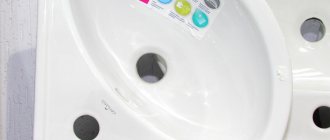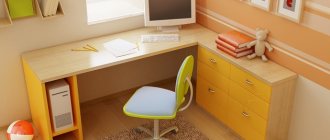For a student of any age, the main object in the room is a desk. He spends a lot of time on it, and not only school performance, but also the child’s health depends on this piece of furniture.
Desk design and shapes
A schoolchild's desk is an integral part of the room's interior. In fact, this is not just educational furniture, but also an object that develops a sense of taste in a child.
Modern tables are thought out to the smallest detail. To ensure that they last a long time and are multifunctional, manufacturers do everything possible. The ability to transform, shape and other criteria are taken into account.
Like the design, the shapes of the tables are very diverse:
- Angular. This shape can be proportional or elongated on one side.
- Classic. This is a rectangular shaped table. Due to its bulkiness, this model is not very popular. But due to its spaciousness, many parents choose this option.
- Round. The table is designed for a group of children to study. It provides excellent visibility and does not restrict movement.
- With a fun design. This option is intended for children in first grade or preschoolers.
A desk for a schoolchild with shelves, drawers, cabinets - a variety of models.
The following models of writing desks are available:
- Orthopedic. It is intended for both work and correction of spinal curvatures and posture correction. In this model, a special recess is made in the tabletop, which does not allow the child to roll over, and therefore he sits upright.
- Transformer. In this model, it is possible to adjust the height, angle of the footrests, and table top.
- Children's computer desk. This is a 2 in 1 table with blocks for a keyboard and system unit. You can do homework or play computer games behind it. But you just need to make sure that the child gives preference to the first lesson.
- "Growing" table. This option is intended for schoolchildren of any age. All thanks to a system that allows you to “grow” the size of the desk as the child grows.
- School corner. It contains hanging cabinets, shelves, cabinets, and built-in lighting. This is a whole mini-world that was created so that the child is not distracted from his studies and feels comfortable.
- Folding/unfolding. This model is good for small rooms. Before classes, the table top is folded out, and at the end it is raised.
What else is worth paying attention to?
When setting up a study corner, do not forget about the immediate future. Children grow quickly, so give preference to furniture that can be resized. Otherwise, you will have to initially rely on standard furniture or change the furnishings in the child’s room every year. In the first case, you risk his health, in the second, your finances.
When choosing furniture for a children's workplace, pay attention to useful little things: magnetic boards, additional shelves and special containers. Unlike ordinary boxes, they are always at hand. When a child is of preschool or primary school age, it is recommended to store important things in a visible place. Otherwise he may forget about them. An excellent option is transparent modules or containers attached to the desktop area.
Creative accessories
Instead of ordinary scissors or paper clips, you can choose accessories of unusual shapes or shades. Your child will be pleased to put pencils in an organizer in the shape of a funny hedgehog. And it is much more interesting to fasten sheets of the next abstract with multi-colored strong ones than with ordinary gray ones. This will teach the baby to have order, and will also instill in him a love for school.
Desk for two children
If there are two children and there are no extra rooms, variations of writing tables have been developed, designed for several schoolchildren.
Designers have come up with some tricks for such cases:
- Corner model. Each side will be specifically determined for a specific child. But the countertops must be long enough to provide enough space for everyone.
- Wide model. With this solution, children study opposite each other.
- Long table top. This option will allow you to create two jobs. You can place cabinets under the table, and a large number of wall cabinets and shelves above the table.
Additional furniture
It is very important for a student to properly organize the space around him. If there are a lot of unnecessary things nearby, piled up in large piles, this will not promote concentration. The student's attention will wander. The student's workplace at home should have additional furniture. These can be various bedside tables, wall cabinets, shelves or bookcases. It all depends on the style of the interior, as well as the free space in the room. Textbooks, notebooks, and office supplies should be at hand. The student should have easy access to them. Therefore, it is necessary to install all additional furniture elements so that the child can simply reach the cabinet or shelf. Cabinets should not be hung high. Due to inconvenient access to their things, the child will feel discomfort. His workplace will evoke negative associations.
Storage systems
Many factors influence productivity, and a tidy desk is one of them. It is important to properly organize storage systems: put pencils in special glasses, place books on additional shelves, put notebooks in niches and drawers. It is also good to use magnetic, cork, and slate boards, on which it is convenient to leave important notes and attach notes. Children often forget something, so such an item will teach him to self-organize.
Material
Tables are made from various materials - natural and artificial:
- Chipboard. Due to its reasonable price and wear resistance, this material has gained a strong foothold in the market. It is harmless, but if the production technology is not followed, after 5-7 years it can release formaldehyde resins, which is harmful to the health of the child.
- MDF. This is a material without synthetic excess, from a natural composition. It is waterproof and very durable. Its price is higher due to its naturalness.
- Natural wood. Solid wood is the most natural and high-tech option. Such models are durable and high quality. Their price is higher than previous options.
- Plexiglas. This may be the covering of the countertop or the countertop itself is made of this material. This is a good option for light floors.
Choosing a table for a schoolchild
When going to buy a desk for a child, parents should focus on quality and safety, and only then on beauty and design.
The table is selected according to the child’s height. During classes, the child's feet should be firmly on the floor. In this case, the angle of the bent knees should be approximately 90 degrees, and the elbows should be located on the tabletop. It should be large in size so that all the necessary accessories can be easily located here.
When purchasing a table, you should read the quality certificate to ensure that the product is environmentally friendly. If it is not possible to change the table as the child grows, it is better to consider the option of a “growing” table.
The table must be equipped with cabinets and shelves, and most importantly, a chair. It, like the table, must correspond to the height and age of the child. For convenience and to ease the load on the child’s back, the chair should have a backrest. Soft options are best.
It is advisable to hear the child’s opinion when purchasing all these items. After all, he will have to study in this place for more than one month and this will be his own corner.
Colors in the interior
Psychologists and designers agree that it is necessary to choose neutral color schemes for a student’s workplace. You can use white or beige as the background, and choose furniture or accessories in brighter and more interesting shades. There should not be a lot of colored elements so as not to distract the child from doing homework. Brown and yellow colors are able to focus attention and stimulate brain activity, so they are recommended to be used as accent colors.
Green color in the interior
When designing a workplace at home, you need to pay attention to the color scheme. Green shades are considered one of the best options. There shouldn't be too many of them, but as a complement to a neutral base, this color is perfect. Green shades are considered the most familiar to the human eye. They relax the psyche, setting you up for calm. This is a breath of energy that allows you to tune in to work. If the work corner is completely decorated with this color, the student will not be able to get ready for work. Therefore, green shades are combined with light beige and brown colors of furniture and accessories. A few splashes of red will liven up such an interior. In this case, it is allowed to use any light shades of green. They may approach blue or yellow.
Yellow shades of the interior
According to doctors, yellow is one of the preferred colors when decorating an indoor work area. However, it should not be used in its pure form. It is better if bright yellow colors are present in accessories. These shades tone, stimulating human intellectual activity. Therefore, when decorating a workplace at home, yellow shades should be considered as one of the best options. Walls and ceilings should not be painted this color. Yellow accessories or furniture would be preferable. This is a light, warm color. However, the child must first like it.
Location
The ideal location for a desk is considered to be an area near the window. Natural light is a great option for a child. You can build the tabletop into the window sill, which will significantly save space. If there is a heating system underneath, then you should abandon this idea. As an exception, the heating radiator has individual temperature control.
There are bed-loft systems. There is a table under the bed. The result is a children's mini-office.
The corner model can also be used for zoning a room. But in this case, the table should not interfere with the child while playing.
Study area lighting
Myopia is the scourge of modern youth. If we look at the statistics, it turns out that 37% of university students suffer from myopia. On average across the country, every fourth Russian experiences vision problems. Oculists and ophthalmologists conduct a lot of research on the dangers of computers, televisions, etc. But they all confirm one rule - you need to take care of your eyesight from childhood. And this is impossible without proper lighting of the student’s workplace.
It is recommended that the student’s workplace be located near the window. First of all, this allows the child to work in good natural light. Secondly, the baby can take a break from lessons and look at the sky, birds and trees. This has a beneficial effect on the student’s mood and allows him to exercise the eye muscles, which are tense while doing homework.
The presence of daylight is a prerequisite for a child’s workplace. But besides this, of course, you need a personal lamp - bright, safe, comfortable. They usually place it on the table on the left if the child is right-handed (and vice versa).
How to choose a lamp?
Main criteria:
- The light should be as close to natural as possible. We choose a lamp with yellow light - an incandescent lamp of 60-80 watts. Don’t skimp on your child’s vision—energy-saving white light bulbs won’t do! Halogen light bulbs are too bright for a baby - they are not worth purchasing.
- Luminescent ones are also not an option - their invisible flicker tires the eyesight.
- In addition to your own lamp, of course, there must also be general lighting in the room, otherwise the child’s vision will deteriorate very quickly. This could be a chandelier, sconce, or additional lamps.
- Design of a child's table lamp. Basic requirements: minimum elements. The child should not have the desire to disassemble the lamp or play with it. Therefore, lamps in the form of toys are not suitable for first-graders. Various decorative elements in the form of crystal, etc. are also undesirable. They create glare, which negatively affects vision.
- Safety. The lamp must be shockproof. So that the child, while playing, does not accidentally break it and get hurt.
- The lamp must have a lampshade (preferably yellow or green) so that the light does not blind the child.
- It is desirable that the design of the lamp allows you to change the angle of its inclination, and that the base of the lamp is carefully secured to the table using a bracket.


